American Airlines conspired to make a 2,361-mile, 8-hour set of flights into a 23-hour planes, trains and automobiles odyssey. I arrived wiped out to L’Horizon Resort in Palm Springs, CA, the location for the Range Rover Velar Global Media Launch. Four hours later, the call came for breakfast, and through puffy eyes I could finally see why Land Rover chose this venue.
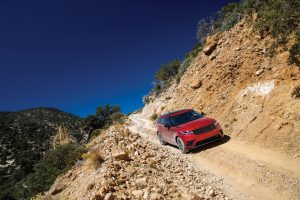 The Coachella Valley of southern California, with its surrounding mountains and hard rock desert, made for great settings for Hollywood movies. By the 1930s, film luminaries had made Palm Springs the “Playground on the Stars.” Cinematic celebrities soon attracted celebrity architects who promoted a “post-modernist” look of expansive glass walls and flat roofs.
The Coachella Valley of southern California, with its surrounding mountains and hard rock desert, made for great settings for Hollywood movies. By the 1930s, film luminaries had made Palm Springs the “Playground on the Stars.” Cinematic celebrities soon attracted celebrity architects who promoted a “post-modernist” look of expansive glass walls and flat roofs.
The city and the country provided the perfect backdrop for the newest model and Land Rover gave us a full day of back road, highway and off-road driving in and around the Joshua Tree National Forest. Palm Springs sits like an urban oasis in a hardscrabble desert. Palm trees line the boulevards which feature imposingly chic buildings. Together, they provided the perfect backdrop for the stylish Velar.
 It’s a genuine stop-you-in-your-tracks Land Rover, with a profile that sweeps elegantly from front to rear. A waistline runs straight down the flanks, while the roof slopes ever so gently towards the stern. While the Velar looks substantial in size, at 65” it sits nearly a foot lower than the Discovery II or LR4. Land Rover’s Gerry McGovern named the styling behind the Velar as “reductionism.” Although the wheelbase is a whopping 13” greater than a Discovery II, the overall length difference is but 4”. There’s a tautness to the Velar that makes a large vehicle look sleek and distinctive.
It’s a genuine stop-you-in-your-tracks Land Rover, with a profile that sweeps elegantly from front to rear. A waistline runs straight down the flanks, while the roof slopes ever so gently towards the stern. While the Velar looks substantial in size, at 65” it sits nearly a foot lower than the Discovery II or LR4. Land Rover’s Gerry McGovern named the styling behind the Velar as “reductionism.” Although the wheelbase is a whopping 13” greater than a Discovery II, the overall length difference is but 4”. There’s a tautness to the Velar that makes a large vehicle look sleek and distinctive.
The front overhang appears minimal and the rear appears to be tight, without sacrificing functionality. The body stretches an additional 6” from the Discovery I/II era, but the wheel wells look better integrated into the body than on the Evoque. The vents on the front wings serve a real cooling function. The rear glass overhang helps keep the rear window clean. The door handles retract flush to the body until you need them (yes, they can break through ice and there is a workaround). The front headlights and rear taillights also sit flush to the body to reduce air noise and contribute to a Cd of .32, while offering 34.4 cu ft. of cargo capacity with 5 seats, 70.1 with the rear seats folded down.
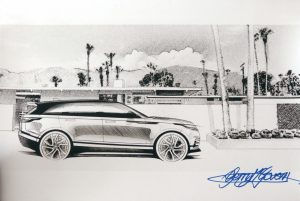 Mark Burnistone, the Vehicle Engineering Manager for the Velar, said, “My job was to create the character of the car, merging its styling and engineering. The team is most proud of the lack of dilution from the first designs to the finish. The task kept delivering Charles Spencer King’s voice in my ear —“Make sure it works off-road and in all terrains.” As with all the new Land Rover models, it looks too precious to head off-road, but the Velar has an approach angle of 24 degrees, a ramp angle of 20.1 degrees, and a departure angle of 26.3 degrees. The “official” wading depth is 24”, and the ground clearance at the axles ranges from 8.4 [coil springs] to 9.8 [air suspension]. Despite its longer wheelbase, the turning radius and turns lock-to-lock require less room and effort than the Discovery I/II.
Mark Burnistone, the Vehicle Engineering Manager for the Velar, said, “My job was to create the character of the car, merging its styling and engineering. The team is most proud of the lack of dilution from the first designs to the finish. The task kept delivering Charles Spencer King’s voice in my ear —“Make sure it works off-road and in all terrains.” As with all the new Land Rover models, it looks too precious to head off-road, but the Velar has an approach angle of 24 degrees, a ramp angle of 20.1 degrees, and a departure angle of 26.3 degrees. The “official” wading depth is 24”, and the ground clearance at the axles ranges from 8.4 [coil springs] to 9.8 [air suspension]. Despite its longer wheelbase, the turning radius and turns lock-to-lock require less room and effort than the Discovery I/II.
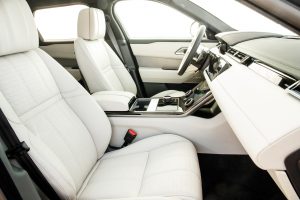 The Velar will move rapidly and efficiently. Even with the 1,997cc, twin-turbo Ingenium 4-cylinder, the Velar delivers 247 hip and 269 ft-lb of torque, good enough for a 0-60 mph in 6.4 seconds, with a top speed of 135 mph. If that’s not enough, tick off the option box for the 3.0-liter V-6, with 380 hip and 332 ft lbs of torque. Your fuel mileage will suffer, but if that’s important to you, select the 2.0L turbodiesel with 180 hip and a powerful 317 ft lbs of torque. All come mated the same 8-speed ZF transmission, running through a clever all-wheel drivetrain that uses electronic wizardry instead of mechanical gears, to provide the right traction at the right time for any driving condition (a rear locking differential is optional). At 4,217 lbs of aluminum, steel, and magnesium, it weighs less than my Discovery I, but returns an EPA combined mileage of 23 mpg (2 L petrol).
The Velar will move rapidly and efficiently. Even with the 1,997cc, twin-turbo Ingenium 4-cylinder, the Velar delivers 247 hip and 269 ft-lb of torque, good enough for a 0-60 mph in 6.4 seconds, with a top speed of 135 mph. If that’s not enough, tick off the option box for the 3.0-liter V-6, with 380 hip and 332 ft lbs of torque. Your fuel mileage will suffer, but if that’s important to you, select the 2.0L turbodiesel with 180 hip and a powerful 317 ft lbs of torque. All come mated the same 8-speed ZF transmission, running through a clever all-wheel drivetrain that uses electronic wizardry instead of mechanical gears, to provide the right traction at the right time for any driving condition (a rear locking differential is optional). At 4,217 lbs of aluminum, steel, and magnesium, it weighs less than my Discovery I, but returns an EPA combined mileage of 23 mpg (2 L petrol).
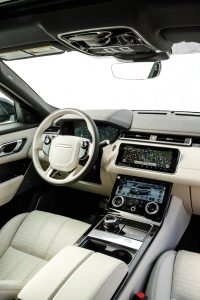 The combination of power and weight makes for an exhilarating driving experience. As enthusiasts, we don’t really care about the competition, but Land Rover must pay attention; in the case of the Velar, Burnistone cited the BWM X4, Mercedes GLC, Audi Q5 and the Porsche Cayenne. With the explosive popularity of multiple sizes and capabilities of SUV’s, Land Rover feels it must have a model in each market niche. The Velar carries more people and cargo than the Evoque, has a driver orientation different than the Discovery, and starts at a price point $25,000 below than the Range Rover Sport.
The combination of power and weight makes for an exhilarating driving experience. As enthusiasts, we don’t really care about the competition, but Land Rover must pay attention; in the case of the Velar, Burnistone cited the BWM X4, Mercedes GLC, Audi Q5 and the Porsche Cayenne. With the explosive popularity of multiple sizes and capabilities of SUV’s, Land Rover feels it must have a model in each market niche. The Velar carries more people and cargo than the Evoque, has a driver orientation different than the Discovery, and starts at a price point $25,000 below than the Range Rover Sport.
Stepping into the Velar demonstrated that the interior design team had also created a space that looks and feels right as a Range Rover, but unique to the Velar. The entire cabin felt airy and spacious, with only the most essential controls visible until you called for them. If you enjoy playing with options on your phone or tablet, the twin-screen center panel in the Velar will entice you. If you yearn for knobs to turn or buttons to push, you’ll feel neglected. That said, my new Samsung phone controls could take a lesson from the Land Rover interior design group. Suffice to say that if you’re a neophile or early adopter, the Velar will please you with its digital displays and options — but even automotive traditionalists will find the controls intuitive.
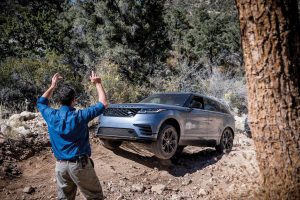 The driving day would offer us the chance to experience each of the three engine options. The planned route took us out of Palm Springs onto a short stretch of interstate, and then up the twisting mountain roads and off-road trails in and around the Joshua Tree National Forest. Bob Burns, JLR North America’s Land Rover events manager, chose to keep me on a short leash and stuffed me in the lead car of the off- road convoy. I thought it might be in recognition of my skills, but Bob told me, “It will let me keep an eye on you!” I joined Bob, Richard Truett of Automotive News and Land Rover’s Mark Burnistone, the experience akin to a lawyer sitting in on Supreme Court justices’ chitchats. It also meant that if I embarrassed myself, Land Rover’s Gerry McGovern and JLR North America executives Joe Eberhardt and Simon Turner would be inconvenienced. I followed Bob Burn’s verbal dictates and marshaling signals with great care.
The driving day would offer us the chance to experience each of the three engine options. The planned route took us out of Palm Springs onto a short stretch of interstate, and then up the twisting mountain roads and off-road trails in and around the Joshua Tree National Forest. Bob Burns, JLR North America’s Land Rover events manager, chose to keep me on a short leash and stuffed me in the lead car of the off- road convoy. I thought it might be in recognition of my skills, but Bob told me, “It will let me keep an eye on you!” I joined Bob, Richard Truett of Automotive News and Land Rover’s Mark Burnistone, the experience akin to a lawyer sitting in on Supreme Court justices’ chitchats. It also meant that if I embarrassed myself, Land Rover’s Gerry McGovern and JLR North America executives Joe Eberhardt and Simon Turner would be inconvenienced. I followed Bob Burn’s verbal dictates and marshaling signals with great care.
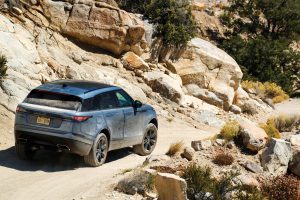 On pavement, the Velar proved quick, quiet, responsive and powerful. Our short drive on an interstate confirmed that if you let your attention wander, speeding tickets could accumulate rapidly. Turning off an exit quickly brought us to a series of narrow, two lane mountain roads that the Velar ate up with aplomb. Richard Truett drives many different automobiles for a living and he sounded quite pleased with his time behind the wheel.
On pavement, the Velar proved quick, quiet, responsive and powerful. Our short drive on an interstate confirmed that if you let your attention wander, speeding tickets could accumulate rapidly. Turning off an exit quickly brought us to a series of narrow, two lane mountain roads that the Velar ate up with aplomb. Richard Truett drives many different automobiles for a living and he sounded quite pleased with his time behind the wheel.
Off-road, Bob had me lead the convoy through his selected trails. With their alloy wheels and low profile tires, punctures were an ever-present danger, but with Bob and his team’s skilled marshalling, no one had to mount a spare tire. The trails mixed large, sharp rocks and desert sand, ascents and descents, tight turns and rock climbs. The Velar’s 2.2 turns lock-to-lock represent a sharp improvement from the 3.3 turns on my Discovery I, or the unassisted 3.75 turns of my Series II-A, with its 38-ft. turning circle. I found myself sawing at the wheel unnecessarily, until I adjusted to
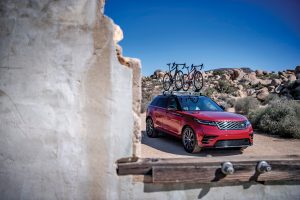
the electronic power steering. We climbed some significant boulders, letting the Terrain Response 2 system determine the right tractive power demanded by each wheel. The Velar climbed up and dropped off all the obstacles without any drama. The monocoque structure demonstrated its stiffness, just as the brilliant drivetrain showed off its capabilities when you lifted the wheel while climbing up an obstacle; there’s no feeling of flex and no spinning of an elevated wheel. Whether on or off- road, the double wishbone front suspension and multi-link rear suspension [a platform shared with the Jaguar F-Pace], worked superbly, whether paired with the air springs [which allow for greater articulation] or the coil spring [base model only].
Bob Burns told me of searching out routes solo in the Velar. At times, he found himself in challenging situations heading down an ever-narrowing trail – once with very little fuel left and far from a gas pump. The Velar tackled every obstacle without needing more than a quick wash.
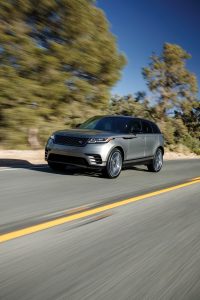
Mark Burniston summed up the Velar as “composed in every circumstance.” The Velar felt that way, whether behind the wheel or relaxing in a rear seat. If seating for 5 with spacious cargo capacity will cover your family or personal needs, the Velar would prove to be the right Range Rover for you. Yes, I miss the mechanical levers and buttons that enabled greater involvement with off road driving, but I could not fault the effectiveness of the digital and drivetrain systems.
I returned to Maine and jumped into my 1997 Discovery I. After 8 hours in a Velar, its controls felt heavy, its ride crude, its acceleration, anemic. Amazing what 20 years of automotive engineering can accomplish. When I relayed this experience to Bob Burns, he said he felt the same in his ’91 Range Rover Classic. With the Velar Land Rover has really upped its game and hints at the future of design and engineering in the next generation of Land Rover vehicles.